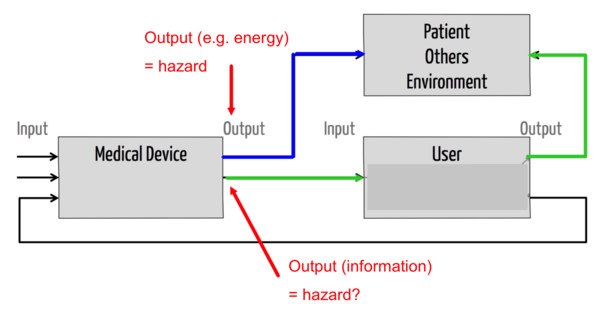Hazard and Hazardous Situation
Even though the ISO 14971 defines the terms hazard and hazardous situation, it is still often not so easy for medical products manufacturers to differentiate these two terms. This article will help understand these terms clearly.
Definition of hazard and hazardous situation
The ISO 14971 defines both terms
Definition: Hazard
„potential source of harm“
Source: ISO 14971:2012
Definition: Hazardous situation
„circumstance in which people, property, or the environment are exposed to one or more hazard(s)“
ISO 14971:2012
Examples of hazards
The ISO 14971 gives as examples of hazards:
- Chemical hazards
- Electric energy
- Mechanical energy
- Electromagnetic radiation
- Thermal hazard
- Biological hazards
- Hazards through (false) information such as manuals or advertisements.
Misconceptions and Challenges with the term "hazard"
As already mentioned, hazards are defined as potential sources of harm. There is no doubt that ionizing radiation (electromagnetic energy), voltage (electric energy), hot surfaces (thermal energy) and moving parts (mechanical energy) are potential sources of harms i.e. hazards.
But an instruction manual? An inadequate specification of the intended use? Are these hazards as well?What's about a wrong display of a drug or a drug dose at a drug management systems?
All these latter examples eventually might lead to a harm, but not directly.
Any element of a casual chain meets the definition of "potential source of harm" e.g.
- Software bug
- Wrong calculation of drug dose dose
- Wrong display of drug dose dose
- Wrong prescription
It is important to have a common understanding of hazard within an organization. Otherwise the risk management file might become inconsistent and probabilities of hazards and harms and thereby risks are inappropriately assessed.
A complementary definition of hazard
We recommend to chose one of the following complementary definitions of hazard:
Definition: Hazards
„Option 1: Hazard is the 'misbehavior of the system at its output (e.g. too hot surface, display of wrong information“
„Option 2: The hazard is the last element in a causal chain previous to the hazardous situation.“
Johner Institute
Further information
The Auditgarant can help you with more than a dozen step by step training videos sessions
- to use the definitions in your risk management file correctly,
- to systematically analyse and identify risks using techniques such as PHA, FMEA and FTA,
- to choose implement and validate the appropriate measures and
- to create an ISO 14971-compliant risk management file and thus for the audit to be successful.
Examples of hazards due to medical devices
Do you know the publication "TOP 10 HEALTH TECHNOLOGY HAZARDS FOR 2013 '?

Almost every other hazard has to do more or less directly with software.
- Alarm hazards
- Medication administration errors using infusion pumps
- Unnecessary exposures and radiation burns from diagnostic radiology procedures
- Patient/data mismatches in EHRs and other health IT systems
- Interoperability failures with medical devices and health IT systems
- Air embolism hazards
- Inattention to the needs of pediatric patients when using “adult” technologies
- Inadequate reprocessing of endoscopic devices and surgical instruments
- Caregiver distractions from smartphones and other mobile devices
- Surgical fires
If you read the whole article, you will notice that the above listed hazards and causes for hazards are mixed with each other.



